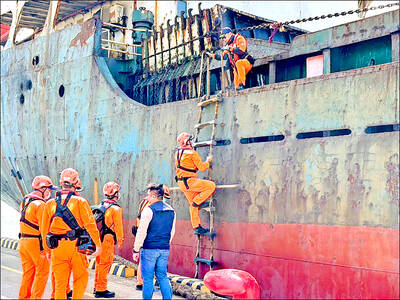Asian stocks fell for a second week, led by commodity producers, after prices of copper and oil declined on speculation slowing growth will curb demand.
BHP Billiton Ltd, the world’s biggest mining company, dropped in Sydney. Mitsubishi UFJ Financial Group Inc led Japanese banks lower after its profit declined and the government said the world’s second-largest economy may be in a recession. Mitsui OSK Lines Ltd led shipping companies after a measure of marine freight fees slumped.
“Commodities prices have hit a choking point,” said Nader Naeimi, a Sydney-based senior investment strategist at AMP Capital Investors, which manages about US$108 billion. “With further evidence of slowing growth there’ll be ongoing pressure on mining and resources stocks.”
The MSCI Asia-Pacific Index fell 2.7 percent to 127.11 this week, extending last week’s 1.8 percent decline. Japan’s Nikkei 225 Stock Average added 0.6 percent. Most other Asian markets declined.
MSCI’s Asian gauge extended its decline this year to 19.4 percent, part of a rout that has erased more than US$13 trillion from equities worldwide since October, as about US$495 billion in writedowns and credit-related losses threaten to push the US into recession.
TAIPEI
Taiwanese share prices are expected to extend gains this week on improved market sentiment as investors hope exports will benefit from the weakening local currency, dealers said on Friday.
Buying may spread across the broader market, in particular with financial stocks in focus on their relatively low valuations after having been battered by global credit woes, they said.
For the week to Friday, the weighted index closed up 206.50 points or 2.95 percent at 7,209.04 after a 3.19 percent fall in the previous week.
Average daily turnover stood at NT$100.76 billion (US$3.25 billion), compared with NT$84.01 billion a week ago.
The TAIEX closed up 184.46 points, or 2.63 percent, from Thursday, dealers said.
“Investors have been relieved to some extent after Friday’s strong showing. Such sentiment is expected to dominate market movements over the next few sessions,” Grand Cathay Securities (大華證券) analyst Mars Hsu said.
The electronic sector is likely to help the upside, Hsu said.
“A weakening Taiwan dollar will no doubt strengthen the sector’s global competitiveness. Several electronic heavyweights have voiced confidence in the outlook. These are quite positive,” Hsu said.
TOKYO
Japanese share prices closed up 0.33 percent on Friday, rebounding from early losses as investors shrugged off an overnight fall on Wall Street, encouraged by a weaker yen, which helps exporters.
The Tokyo Stock Exchange’s benchmark Nikkei-225 index rose 43.42 points to end at 13,168.41. The broader TOPIX index of all first-section shares added 1.12 points, or 0.09 percent, to 1,259.93.
The gains were “partly because the Tokyo market had factored in weakness in US stocks overnight,” Hiroyuki Fukunaga, chief executive officer at Investrust, told Dow Jones Newswires.
“The fact that Toyota didn’t revise downward its earnings forecast was a plus too,” he said.
HONG KONG
Hong Kong share prices closed down 0.99 percent, dealers said.
The benchmark Hang Seng Index was down 218.99 points at 21,885.21.
Castor Pang, an investment strategist at Sun Hung Kai Financial, said trading is likely to remain sluggish next week.
SYDNEY
Australian shares closed flat, dealers said. The benchmark S&P/ASX 200 index closed up 2.9 points at 4,986.2 while the broader All Ordinaries rose 7.6 points to 5,037.6.
SHANGHAI
Chinese share prices closed down 4.47 percent, dealers said.
The benchmark Shanghai Composite Index, which covers both A and B shares, shed 121.86 points on Friday to 2,605.72.
The key index in Shanghai sank to a 19-month low, and analysts said it could slide further despite suggestions from the securities authorities that they wanted to stabilize the market during the Olympic Games.
Investors dumped Olympics-themed stocks with hopes fading for government support before the opening of the Beijing Games, dealers said.
“There are investors who bought these stocks on the hope that Beijing would rescue the markets before the Olympics, and that these stocks would rise more sharply thanks to Olympics fervor,” Everbright Securities analyst Shi Honglin told Dow Jones Newswires.
“These hopes haven’t materialized, which is why investors are dumping these stocks,” Shi said.
SEOUL
South Korean shares closed 0.3 percent higher, dealers said. The KOSPI index rose 4.72 points to 1,568.72.
SINGAPORE
Singapore shares closed 0.96 percent lower, tracking Wall Street’s overnight decline, with worries about weaker corporate earnings on the domestic front hurting sentiment, dealers said.
The Straits Times Index fell 27.17 points to 2,807.54.
KUALA LUMPUR
Malaysian share prices closed 0.8 percent lower, dealers said. The Kuala Lumpur Composite Index shed 9.25 points to 1,120.31.
BANGKOK
Thai share prices closed 2.08 percent lower, dealers said. The Stock Exchange of Thailand (SET) composite index fell 14.65 points to close at 690.70 points, while the blue-chip SET-50 index lost 12.35 points to 487.60.
MANILA
Philippine share prices closed 0.3 percent higher, dealers said. The composite index gained 8.17 points to 2,692.81 points. The all-share index gained 0.18 percent to 1,698.86 points.
MUMBAI
Indian shares closed 0.33 percent higher, dealers said. The benchmark 30-share SENSEX index rose 50.57 points to 15,167.82.
“The markets were rangebound with no sharp buying or selling seen,” Bhaskar Kapadia at Pyramid Securities said.

A Chinese freighter that allegedly snapped an undersea cable linking Taiwan proper to Penghu County is suspected of being owned by a Chinese state-run company and had docked at the ports of Kaohsiung and Keelung for three months using different names. On Tuesday last week, the Togo-flagged freighter Hong Tai 58 (宏泰58號) and its Chinese crew were detained after the Taipei-Penghu No. 3 submarine cable was severed. When the Coast Guard Administration (CGA) first attempted to detain the ship on grounds of possible sabotage, its crew said the ship’s name was Hong Tai 168, although the Automatic Identification System (AIS)

An Akizuki-class destroyer last month made the first-ever solo transit of a Japan Maritime Self-Defense Force ship through the Taiwan Strait, Japanese government officials with knowledge of the matter said yesterday. The JS Akizuki carried out a north-to-south transit through the Taiwan Strait on Feb. 5 as it sailed to the South China Sea to participate in a joint exercise with US, Australian and Philippine forces that day. The Japanese destroyer JS Sazanami in September last year made the Japan Maritime Self-Defense Force’s first-ever transit through the Taiwan Strait, but it was joined by vessels from New Zealand and Australia,

CHANGE OF MIND: The Chinese crew at first showed a willingness to cooperate, but later regretted that when the ship arrived at the port and refused to enter Togolese Republic-registered Chinese freighter Hong Tai (宏泰號) and its crew have been detained on suspicion of deliberately damaging a submarine cable connecting Taiwan proper and Penghu County, the Coast Guard Administration said in a statement yesterday. The case would be subject to a “national security-level investigation” by the Tainan District Prosecutors’ Office, it added. The administration said that it had been monitoring the ship since 7:10pm on Saturday when it appeared to be loitering in waters about 6 nautical miles (11km) northwest of Tainan’s Chiang Chun Fishing Port, adding that the ship’s location was about 0.5 nautical miles north of the No.

COORDINATION, ASSURANCE: Separately, representatives reintroduced a bill that asks the state department to review guidelines on how the US engages with Taiwan US senators on Tuesday introduced the Taiwan travel and tourism coordination act, which they said would bolster bilateral travel and cooperation. The bill, proposed by US senators Marsha Blackburn and Brian Schatz, seeks to establish “robust security screenings for those traveling to the US from Asia, open new markets for American industry, and strengthen the economic partnership between the US and Taiwan,” they said in a statement. “Travel and tourism play a crucial role in a nation’s economic security,” but Taiwan faces “pressure and coercion from the Chinese Communist Party [CCP]” in this sector, the statement said. As Taiwan is a “vital trading